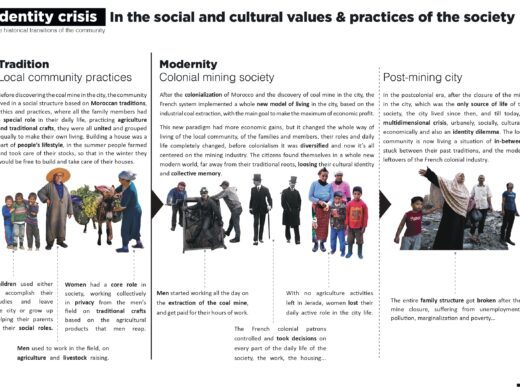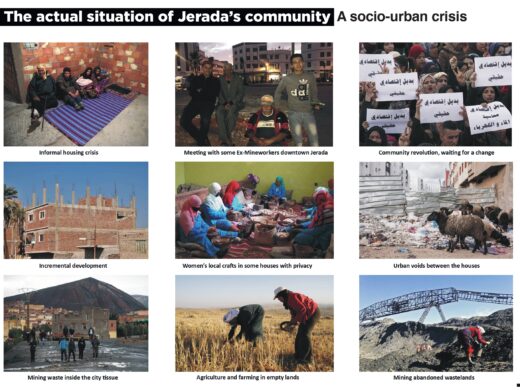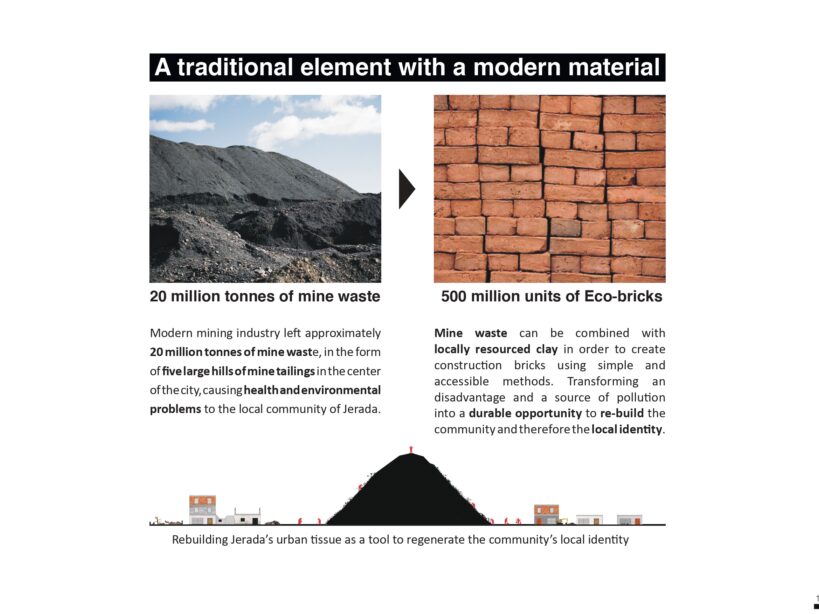Jerada bricks: A new life
Jerada, a socio-urban tragedy
Jerada is a post-mining city located in the northeastern region of Morocco, it was the biggest producer of coal in the country and in Africa, but after the sudden closure of its mining industry, the city started declining. The crisis impacted its economy, its environment and its social and urban structure.
Before discovering the coal mine in the city, the community lived in a social structure based on Moroccan traditions, ethics and practices, where all the family members had a special role in their daily life, men, women and children. But after the colonialization of Morocco and the discovery of coal mine in the city, the French system implemented a whole new model of living in the city, based on the industrial coal extraction, with the main goal to make the maximum of economic profit, in consequence, the local community lost its primary core roles in the society.
Today, Jerada is one of the most problematic territories in the country, stuck between a traditional past and a modern industrial present, and most importantly, with an obscure future.

Jerada’s identity between tradition and modernity
This project aims to analyze the identity crisis of Jerada, how did the city and its local community changed after the French mining colonialism? What future will have this society who struggles till today between their traditional roots, and the modern colonial era of mining? In this context of ‘in between’ tradition and modernity, the project’s vision is to find ways and approaches to rebuild the cultural and urban identity of Jerada and its community through architecture and urban design.

I spent two months in Jerada, where I found out that the local community is living a multidimensional crisis since the closure of the mine, socially, culturally, economically and urbanely with the huge problem of informal housing that presents 90 % of the city’s urban tissue. Today, the society of Jerada is living an identity dilemma, losing their cultural identity and collective memory due to the colonial mining era.
Stuck between old traditions and colonial modernism, my primary vision of the project isn’t to erase one of the two identities or to revive one of them, neither to create a hybrid approach between the two, but to use the good of the two worlds, either tradition and modernism have pros and cons, that must be valorized or tackled, and the right choices between them, in order to see what suits today’s needs, could help to rebuild the social and urban identity of Jerada for a better future.

I believe that urban regeneration, resiliency and sustainable development present key elements in rebuilding the social and urban identity of the city and its locals. Through design and architecture, the proposed project aims to rebuild the social and architectural identity of the city of Jerada, by transforming the mining waste tailings in the city tissue, that present the leftovers of modernity, into construction bricks made by the locals, by mixing the waste with clay and water, creating a traditional architectural element using a modern material.
There are 20 million tonnes of mine waste in the city, which gives the opportunity to create 500 million eco-brick made by and for the community, that will help to rebuild the social and urban structure of the city.

The next step of the project is the proposition of multiple strategies and typologies that could be built by the community to fill the city’s different needs, the proposed typologies are based on a functional and a formal analysis of the traditional and modern elements that the community and the city had, in both architecture and social practices, from traditional heritage as the Mousharabieh and the interior patios where women used to work in privacy and agriculture spaces for men’s work, and from the modern colonial era, we had incremental housing that suits the development of the family members in a vertical way.

The whole project is based on a collaborative process between the different parts of the community, the families will transform the mining waste into eco-bricks, and rebuild their neighborhoods. Men work on the created agriculture fields, while women use the agricultural products for their local crafts, both the agriculture and traditional products will generate revenue for the family and help their future developments.

These multiple strategies, typologies and approaches, from new constructions to renovating the existing ones, aim to rebuild the material and immaterial resiliency of the city, reviving the core role of women in the society, developing the eco-durable practices that the city had before mining like agriculture and local crafts by reusing the remnants of modernity as mining waste and industrial wastelands. The project’s main vision is to reshape the social and urban structure of the city of Jerada and its community, giving it a new identity, a new future, and especially, a new way to live, work and dream.

The point of using dummy text for your paragraph is that it has a more-or-less normal distribution of letters. making it look like readable English.

The point of using dummy text for your paragraph is that it has a more-or-less normal distribution of letters. making it look like readable English.

The point of using dummy text for your paragraph is that it has a more-or-less normal distribution of letters. making it look like readable English.

